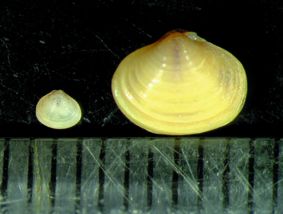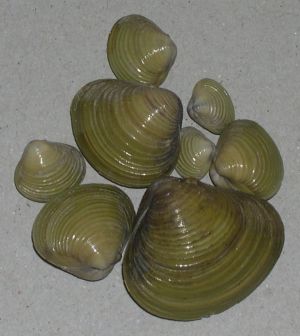|
The Asiatic Clam (Corbicula fluminea) was first noted in Britain in the River Chet, Norfolk in 1998, and since then it has spread throughout most of the rivers of the Norfolk Broads drainage. Specimens of Corbicula were first noted in the Thames by Oliver Whaley at Teddington in 2004. Recent sampling has confirmed that Corbicula is now reproducing in the tidal River Thames. One living juvenile Corbicula was collected by the Environment Agency’s Mark Davison in a kick-net sample taken from just below Teddington Lock (grid ref.TQ 1674 7146) on 20th October 2005.The specimen was confirmed by Ian Killeen.The specimen was alive when collected, and although it measured a little over 1mm across it was still recognised amongst the pea mussels collected with it by the presence of a coarsely sculptured shell and a prominent external ligament.Another juvenile was collected there in November 2005.Two further juvenile individuals measuring 1.9mm and 5.4mm respectively were collected on a subsequent visit to the same site on 18th January 2006.A nearby site at Isleworth (grid ref.TQ 1695 7606) also revealed a live juvenile (20th Nov 2005) and dead shell of an adult (12.0mm across) was collected by colleague Kevin O’Connell on 17th February 2006. The Environment Agency monitors the ecology of the tidal Thames through a network of sites which link into three separate monitoring programs.This record was collected during sampling for the Teddington Low Flow Program, which is a surveillance program developed in response to the need to abstract water from the freshwater Thames for public supply. Sampling is carried out at Teddington, Isleworth, Kew, Barnes and Battersea normally on a quarterly basis.The surveillance program has been running since 1989, prior to the documented arrival of Corbicula in Britain. As flows have been low during the last year sampling frequency has been increased, in an effort to detect any adverse effects of reduced flow. Since the onset of reduced flow conditions last summer, sampling has been carried out on a monthly basis.The EA’s ecological appraisal officers have been attempting to identify most macro-invertebrates to species level rather than the usual family level, in the hope that this increased resolution will assist in the detection of any community changes. Perhaps the increased scrutiny of small bivalves caused this juvenile Corbicula to be spotted whereas it might have been previously missed and erroneously lumped in with Sphaeriidae in earlier years. Other alien species also present in the tidal Thames include Zebra Mussel (Dreissena polymorpha), the Chinese Mitten Crab (Eriocheir sinensis), oligochaete worm Branchiura sowerbyi found near Kew Gardens and the now ubiquitous spiresnail Potamopyrgus antipodarum. Further downstream in more saline water are North American ostracod Eusarsiella zostericola, Portuguese oysters Crassostrea angulata, and a polychaete Marenzellaria viridis The Ecological Appraisal team would welcome any reliable records (and voucher specimens) of the hydrobiid Mercuria confusa (Mercuria c.f. similis in the new Anderson checklist) from the upper estuary. A few specimens were collected by a consultant from the foreshore fronting Fulham Football Club, but a subsequent search for more the following winter was unsuccessful.This may suggest that the original population may have been located upstream, perhaps in reedbeds.The only other known location in the Thames is further downstream in Barking Creek. Contact mark.davison@environmentagency. gov.uk |
Fig 1 Juvenile Corbicula fluminea from Teddington (scale bar mm). (Photo Mark Davison)
Fig 2 Sample of Corbicula from R. Chet, Norfolk. (Photo Evelyn Moorkens) |
Corbicula fluminea in the River Thames
Issue
10
Page
15
Species


